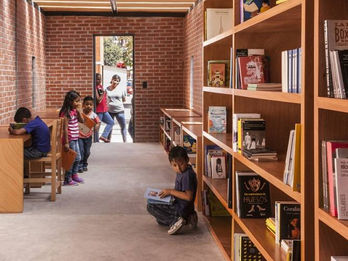2018 Emerge Prize

Common Unity
Rozana Montiel Estudio de Arquitectura
Mexico City, Mexico
January 2016
AUTOR PRINCIPAL
Rozana Montiel Saucedo Estudio de Arquitectura
AUTOR CONTRIBUYENTE
Alin Vázquez Wallach (Designer )
CLIENTE
INFONAVIT (Carlos Zedillo Velasco, CIDS director)
FOTÓGRAFO
Sandra Pereznieto González Jaime Navarro Soto
OBJETIVO
We worked around the barriers created by the inhabitants in order to make them permeable, democratic and meaningful. One of our design strategies to reclaim privatized spaces for public use was to shift the vertical (railing, walls, gates, enclosures) which separate and divide for the horizontal (roof, shelter, floors, passageway) that connects, reunites, and encourages community interaction. The horizontal became more than just a roof: by expanding the program of potential activities in common areas through compact multi-functional structures, our COMMON-UNITY project gathered the community under the same roof. The design of the new space spoke for itself: people willingly gave up 90% of the barriers. Rehabilitating public space restored the community’s use of it, transforming the UNIT into COMMON-UNITY. The recovered public space in Xalpa became an extension of each apartment, while it remained free to the public. The real-estate value of the apartments doubled: the apartments surrounding the rehabilitated areas acquired the added value of community life. Safety was achieved through design. Our intervention was aimed at placemaking: by expanding the program from the perspective of its temporal and multifunctional uses, we transformed the space into a place with identity and character. Placemaking is about understanding architecture as a social construction too. The public spaces we design CHANGE BARRIERS INTO BOUNDARIES. While barriers lock everyone further into conflict, boundaries require people to communicate aspirations as well as uncomfortable issues. Our touchstone was BUILDING TRUST through design.
CONTEXTO
In Mexico City, housing complexes are massive more than 25% of the Mexican population lives in housing units: they are cities in their own right. Residents have a problem of social integration because they lack adequate public spaces. So, housing blocks are notorious for the barriers owners mount to define their limits. COMMON-UNITY is an intervention done in the San Pablo Xalpa housing unit, which has approximately 7,000 inhabitants, and is located in the north part of Mexico City. It is a sectioned housing unit, where zoning and accesses had been altered through fences and barriers built by the inhabitants over time. Public space had been invaded for private uses, was underused, or simply inexistent. In Mexico, because of safety issues, both private property and public areas are protected by railings, walls, fences. Contrary to belief, this phenomenon produces insecurity: protection becomes an obstacle. When we arrived to Xalpa everything was gated, every single square was privatized, and of course, these bars could not be championed. The gates were to a certain extent “untouchable”. The barriers mounted by owners to define their limits, fragmented the landscape into passageways and corridors that pushed social life out of common areas. In fact, most of the neighbors did not even know each other
ACTUACIÓN
It was extremely important to design with the community and not just for the community through the implementation of what we call SITE-ACTIONS. We term site-action a public space intervention designed to involve users in creative ways in order to free space from preconceptions: change begins with a shift of perception. The resulting spaces are filled with life and constant community activity. We implemented roofs with panels that provided blackboards, climbing walls, nets, handrails, ropes, rings and monkey bars, to make it a multifunctional space appealing to all age-groups. Also, our intervention called EL SALONCITO transformed an old leaky shed into a library. The tin-roof shanty was already a multipurpose room for school tutoring, knitting clubs and religious instruction; the new space we designed brought out all the potential of the old space in the same place. We went from a depressed storage-room to a sunny library reading room. Today, people sweep the space early in the morning, young people come and exercise, ladies sit in their knitting club, old folks play chess, and at night there are open-air cinema shows. There are school tutoring classes, zumba and yoga classes, parties, religious celebrations. The space has access to Free Wi-Fi and now people gather around to work with their laptops. The spaces we design engage people in daily routines of rapport and exchange that give them a sense of pride and ownership. Our horizontal intervention of common spaces creates a democratic horizon: it rebuilds society as a whole.











